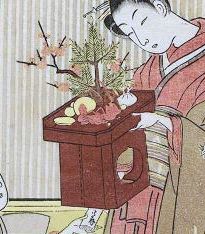
|
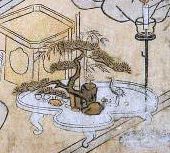
|

|
|
Harunobu, c.1768-69.
|
Harunobu, c.1769. | Bunchō/Harunobu, c.1769-70. |
|
The Work: The Thousand-year Compact Pine, a nishiki-e ink and color on paper chuban (28.2 x 21.5 cm) from about 1768-69, this shows a pine branch in front of a blossoming plum branch on a square wooden tray-stand with beveled corners. This is mounted on a box, of similar material and slightly smaller horizontal proportions, that has at least one circular cut-out. This is being held just right of center by the woman for the viewing pleasure of the kneeling/seated man in the scene. Cursive calligraphy is in a cloud-like border near the top of the print and a screen with a pair of cranes (?) is just left of center behind the human figures. The Artist: Suzuki Harunobu (aka Choeiken, 1724-1770) lived in Edo, was a pupil of Shigenaga, and was influenced by Toyonobu, another of Shigenaga's students. Harunobu's life marks the most important epoch in Ukiyo-e history, for he brought into being true polychromatic prints, and has the earliest examples in which a background is introduced. His prints, especially of female figures, are valued for their beauty, charm and rarity, lyricism and purity of feeling. His works gave rise to many imitators. 1 The Work: Wedding Ceremony, in the Marriage series, a nishiki-e ink and color on paper chuban (28.4 x 20.8 cm) from about 1769, this shows a pine-like branch on a tri-lobed tray to the right front corner of the scene, which also has thirteen people. Each lobe has a long curving foot. The tray holds two larger brown stones and a number of white pebbles. A small toy crane is on the right-hand side under the three branches and apex foliage pad. This ikebana does not appear to be a representation of the "Three Friends of Winter" or other popular symbol of good luck. The Artist: Suzuki Harunobu. 2 The Work: Performer and Courtesan Parodying the Armor-Pulling Scene from the Story of the Soga Brothers. A chuban, (28.1 x 21 cm), it shows a medium-sized pine on a large dish which is seen behind an ikebana arrangement in a vase. The dish and vase are both sitting on a chair or stand. The Artist: Ippitsusai Bunchō (aka Soyoan, 1725-1794) who lived in Edo and worked between 1755 and 1790. He was a follower of and co-painter with Shunshō (1729-1792, one of the Katsukawa leading artists of Ukiyo-e, particularly in both original and printed artist-portraiture). Bunchō, a writer of comic poems and an actor, specialized in female figures and actors, and also was influenced by Harunobu, who co-created this work. 3 |
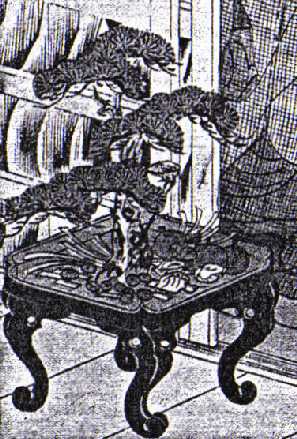
|
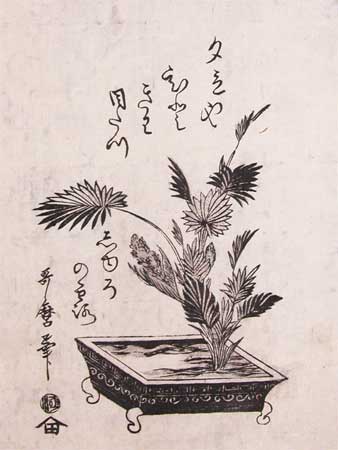
|
|
* Koryusai, late 18th cent.
|
Utamaro, 1804 |
|
The Work:
Lovers under a Mosquito Net, which shows a medium-size informal upright pine
with an orange, tan, and black trunk and at least one
jin
(bare deadwood branch). The tree appears to rise out of an orange-topped black
lacquered four-footed stool, upon which also rests, surrounding the pine, what look
like finger-foods of vegetable strips and round fruits.
The Artist:
Koryusai (b. Isoda Masakatsu,
1721-1789), who lived in Edo, was a pupil of Shigenaga, and was influenced by
the technique of Harunobu. He is said to have been a
ronin,
a masterless samurai. He was the major producer of prints of women
after Harunobu’s death, a very large number of these during the 1770s.
Around 1781 he began to specialize in paintings, of which he created many
good examples.
4
The Artist: Utamaro Kitagawa (b. Toriyama Shimbi, 1753-1806) was the star of the golden age of Japanese printmaking (1789-1801) and the most celebrated artist of women of the whole Ukiyo-e school. Over the course of his highly successful career he produced prints for no fewer than fifty-two publishers. His specialty was the female figure, and he excelled at sensuous depictions, at conveying the sense of the glistening skin of the female body and capturing the most delicate nuances of emotional states. This was in a very different manner from Kiyonaga, who Utamaro replaced. However, some of the latter’s prints contained political messages that the authorities considered dangerous, and at one time he was even arrested and imprisoned because of them. He also produced many illustrated books, erotic prints and some fine paintings. 5 |

|
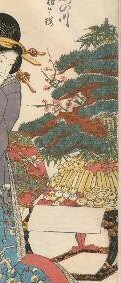
|
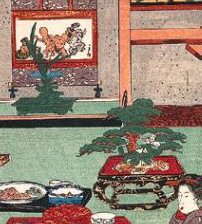
|

|
|
II-ka1810, c.1830
|
II-ka2115a, c.1840
|
II-ka1456-c, c.1840 |
IV-ka6233a, 4/1854
|
|
The Work:
Surimono
from the
Four Kings
[or
Guardian Gods
]
series, with the actor Iwai Kumesaburo II; dated: c.1830; signature: Kochoro Kunisada ga.
The Artist: Utagawa Kunisada (b. Tsunoda Kunisada, 1786-1864) became a pupil of Toyokuni at age fifteen. With Kuniyoshi and Hiroshige, Kunisada was the leading Ukiyo-e artist of the late Edo period. He is said to have produced a larger number of works than any other Ukiyo-e artist. In 1844 he assumed the name Toyokuni III and afterwards led an atelier of some twenty-eight pupils in producing ever-larger series of actor portraits and prints of beauties, of increasingly technical complexity. 6 The Work: Bijin print Takinogawa, Aioizakura ( Takinogawa: Aioi cherries ) from the Viewing cherry blossoms in Edo series; publisher: Yamamotoya Heikichi; dated: c.1840; signature: Kochoro Kunisada ga. The Artist: Utagawa Kunisada. 7 The Work: Bijin print, no title; publisher: Yamamotoya Heikichi; dated: c.1840; signature: Kochoro Kunisada ga. Front-right is an ikebana, left-rear is a bonsai. The Artist: Utagawa Kunisada. 8 The Work: Ayame mae from the Famous stories and flower arrangements series; publisher: Moriya Jihei; dated: 4/1854; signature: Kochoro Toyokuni ga. The Artist: Utagawa Kunisada (Toyokuni III). 9 |
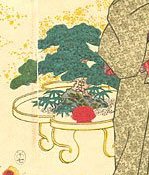
|
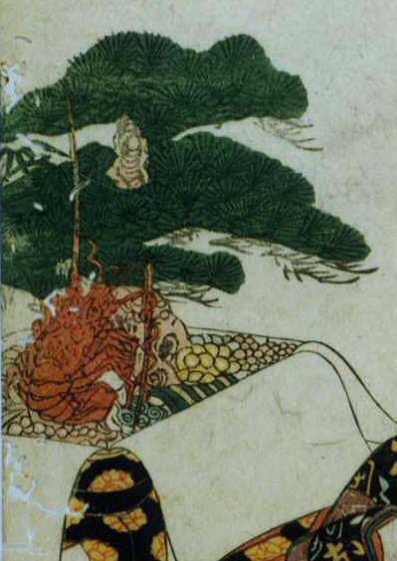
|

|
|
I-ka141, 7/1858
|
V-ka9031-r, 7/1858
|
Shuntei, early 1820s
|
|
The Work:
Unidentified chapter from the
Fifty-four Chapters of the Tale
of Genji
series; publisher: Wakasaya Yoichi; dated: 7/1858; signature: Toyokuni ga.
The Artist: Utagawa Kunisada (Toyokuni III). 10 The Work: Kabuki diptych from an unidentified play with actors Segawa Kikunojo V and Nakamura Shikan I in the roles of Ogiya and Yugiri, respectively; publisher: Kawaguchiya Uhei; dated: c.1820 [sic]; signature: Gototei Kunisada ga. The Artist: Utagawa Kunisada. 11 The Work: Parody of the God Ebisu from the series Shichifukujin (Seven Gods of Good Fortune) for the Hanahasaren poetry club, a shikishiban (19 x 22 cm) showing the same theme as the previous: a lobster and pine bough in a box. The Artist: Katsukawa Shuntei (b. Yamaguchi Chojuro, 1770-1824) produced book illustrations in addition to surimono and other forms. 12 |
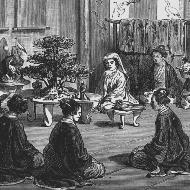
|
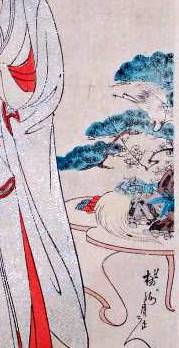
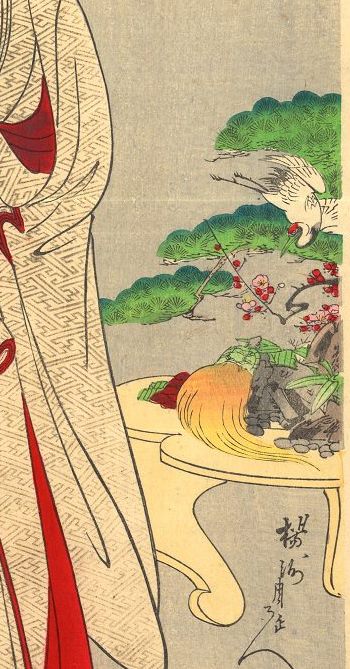
|
|
Unidentified print, 19th century
|
c.1896 (detail of image from two different sources)
|
|
The Work: European (?) woman contemplating an ikebana in Japan, second half of 19th century. 13 The Work: Beauty in Silver Kimono from the Azuma series; publisher: Fukuda Hatsujiro; dated: 1896. The Artist: Yoshua Chikanobu (1838-1912), born in Niigata Prefecture as Hashimoto Tadayoshia, was trained in Kano School painting and then was a student of Utagawa Kuniyoshi and later of Toyohara Kunichika, who gave him his artist's name. He began producing designs in the classic manner of the woodcut masters around 1870, concentrating upon both portrayals of beautiful women and scenes from Japanese legend and folklore. He made his artistic reputation in the 1880's with triptychs illustrating political events of the Meiji period, depictions of the Imperial family, contemporary warfare, the pleasures of the noble courts, scenes from the Noh theatre, and customs and manners of a changing Japan. His later art (particularly those woodcuts relating to the theatre) are remarkable for their bold design elements and beautiful printing techniques. With the exception of Yoshitoshi, his style was perhaps more individualistic than any other Japanese woodcut artist of the times. 14 |
|
Other such prints for which we do not yet have illustrations: The Work: Girl Reading a Letter While Listening to Koto and Shamisen Music, an oban, shows a large pine with distinct left, right and apex foliage pads. The tree is planted right of center in a wide large quatrefoil pot which rests on a curved-leg dark table in an open room to the right/back of the work. There is a sword-leaved companion plant to the left and right of the pine in the pot. The container hints at this possibly actually being an ikebana, but the shape of the pine indicates other – at least to our contemporary eyes. The Artist: Torii Kiyomitsu. 15 The Work: Festival Day at the Gay Quarters in Yoshiwara ( uki-e ), an oban, it shows a pine tree in a low round pot on a low stand in the middle of the room among clientele and geishas. (A "conga line"-like arrangement forms right front to center!) Again, there is some possibility this might actually portray an ikebana, but the left, left center, and right foliage pads point to an artistic dwarf potted tree. The Artist: Torii Kiyomitsu. 16 The Work: Moon Viewing Party at a Teahouse in Shin Yoshiwara ( uki-e ), an oban, this shows a tree in a tray on a stand behind a man in the lower left front corner. Possibly this is an elaborate ikebana in a fairly deep container. The Subject: In 1657, when over half of Edo was reduced to ashes in a great fire, the government ordered the gay quarters moved to Asakusa. There Shin Yoshiwara was established on twenty-seven and a half acres. Two years after it opened, it developed into a literally nightless city -- an island of activity surrounded by rice paddies. The clientele changed almost completely from the warrior class to the merchant class as a result of the abrupt rise in their financial power by the end of the seventeenth century. The history of prosperity in Shin Yoshiwara continued until 1957, when the government was pressured by the recent Western Occupation authorities to pass a law prohibiting prostitution. The Artist: Nishimura Shigenaga (1697-1756) was influenced by Kiyonobu and his pupil Masanobu (1690-1768), who contributed much to the promotion of the beni-e print. His specialty was female figures, but also did actor prints, landscape series, classical themes, parody prints, perspective and historical prints. 17 "Painted wooden boards with Bonsai motives" at Gabi_Greve_at_Ho_En_Shrine, per Chris Cochrane's Posting #8 on 21 Jan 2007 to the Internet Bonsai Club (no longer archived). * * |
|
Smith, Lawrence (ed.) Ukiyoe, Images of Unknown Japan (London: British Museum Publications Ltd.; 1988), pp. 25-26;
Index of Japanese Painters, compiled by the Society of Friends of Eastern Art (of Toyo Bijutsu Kokusai Kenkyukai)(Tokyo: Charles E. Tuttle Company; 1940. First Tuttle edition published 1958), pg. 127. 3. Keyes, Roger S. Surimono, Privately Published Japanese Prints in the Spencer Museum of Art (Tokyo/New York: Kodansha International Ltd.; 1984), # 111, pg. 145 (Ainsworth A184); Index, SFEA, pg. 15. Charles E. Tuttle Company; 1940. First Tuttle edition published 1958), pg. 68; Marks, Andreas Japanese woodblock prints -- Artists, Publishers and Masterworks 1680-1900 (Tokyo: Tuttle Publishing; 2010), pp. 48-49. 4. Resnick, Susan M. Bachenheimer Bonsai (Boston: Little, Brown and Company; 1991, 1992), pg. 13, color photo, which has name as “Koyusai”; Smith (ed.), pg. 28; Index of Japanese Painters, compiled by the Society of Friends of Eastern Art (Toyo Bijutsu Kokusai Kenkyukai)(Tokyo: Charles E. Tuttle Company; 1940. First Tuttle edition published 1958), pg. 68. 5. Ronin Gallery, http://www.japancollection.com/uview.php?aid=158&y=1&pid=3534&pg=2&ppp=12. 6. From Horst Graebner to RJB in personal e-mail, 28 July 2006. Providence given as Boston Museum 7. From Horst Graebner to RJB in personal e-mail, 28 July 2006. Source is given as "Östereichisches Museum für angewandte Kunst." 8. From Horst Graebner to RJB in personal e-mail, 28 July 2006. "Reference: Präfektur Yamaguchi." 9. From Horst Graebner to RJB in personal e-mail, 30 July 2006. Source is given as "Art Research Center, Ritsumeikan University." 10. From Horst Graebner to RJB in personal e-mail, 27 July 2006. Source is given as " Arts and Designs of Japan." 11. From Horst Graebner to RJB in personal e-mail, 31 July 2006. Source is given as "Art Research Center, Ritsumeikan University."
12.
Marks, pg. 102, which also states that as some sources say Shuntei died in 1824
and "in 1821 and 1822 books were published with his illustrations, 1824 seems to be more likely." Print from the
Erich Gross Collection, Switzerland; 13. From www.uk.garden.com, a now defunct site. RJB has seen this picture elsewhere also. 14. "Yoshu Chikanobu," http://www.artoftheprint.com/artistpages/chikanobu_yoshu_tavellerinthesnow.htm ; "Fine Chikanobu Triptych 'King Gusan', c.1880," http://www.antiqnet.com/detail,chikanobu-triptych-king,694539.html ; Chikanobu -- "Beauty in Silver Kimono," http://www.ukiyoe-gallery.com/detail-b86.htm, left-hand image; per personal e-mail to RJB from Gary D. Gross (of http://www.chikanobu.com ) on 27 Mar 2007 (source of right-hand image), the series name is elsewhere erroneously given and repeated as the mistranslated "Akawa-ma." 15. Kikuchi, Sadao A Treasury of Japanese Wood Block Prints, Ukiyo-e (New York: Crown Publishers, Inc.; Translation ©1969 by Tokyo International Publishers, Illustrations ©1963 Kawadeshobo, Tokyo. Translated by Don Kenny), small b&w # 257, pg. 12, also from Tokyo National Museum. 16. Kikuchi, small b&w # 259, pg. 12, Watanabe collection Tokyo; cf. Moromosa's similar print. 17. Kikuchi, pg. 34 and small b&w # 170, pg. 11 from Tokyo National Museum; Index, SFEA, pp. 75, 100; Keyes, Roger S. Japanese Woodblock Prints, A Catalogue of the Mary A. Ainsworth Collection (Oberlin, OH: Oberlin College; 1984), pg. 20; Smith (ed.), pg. 26. |